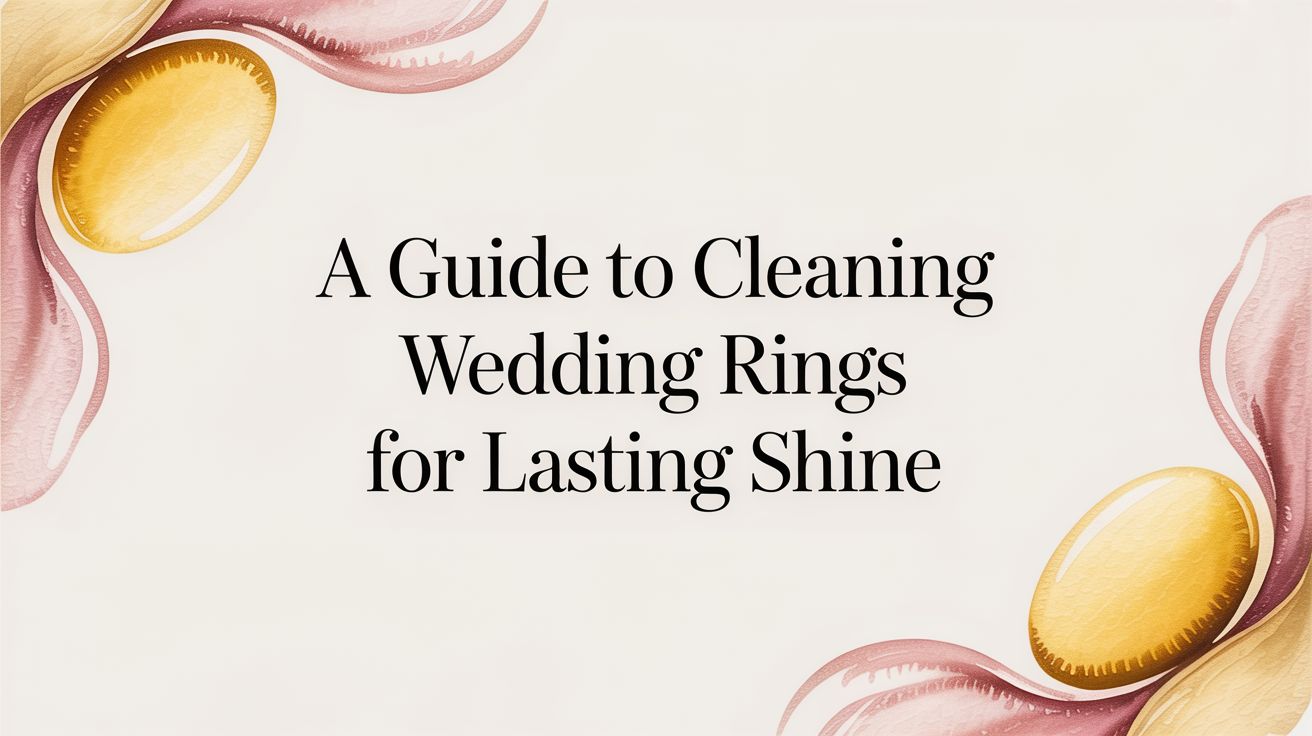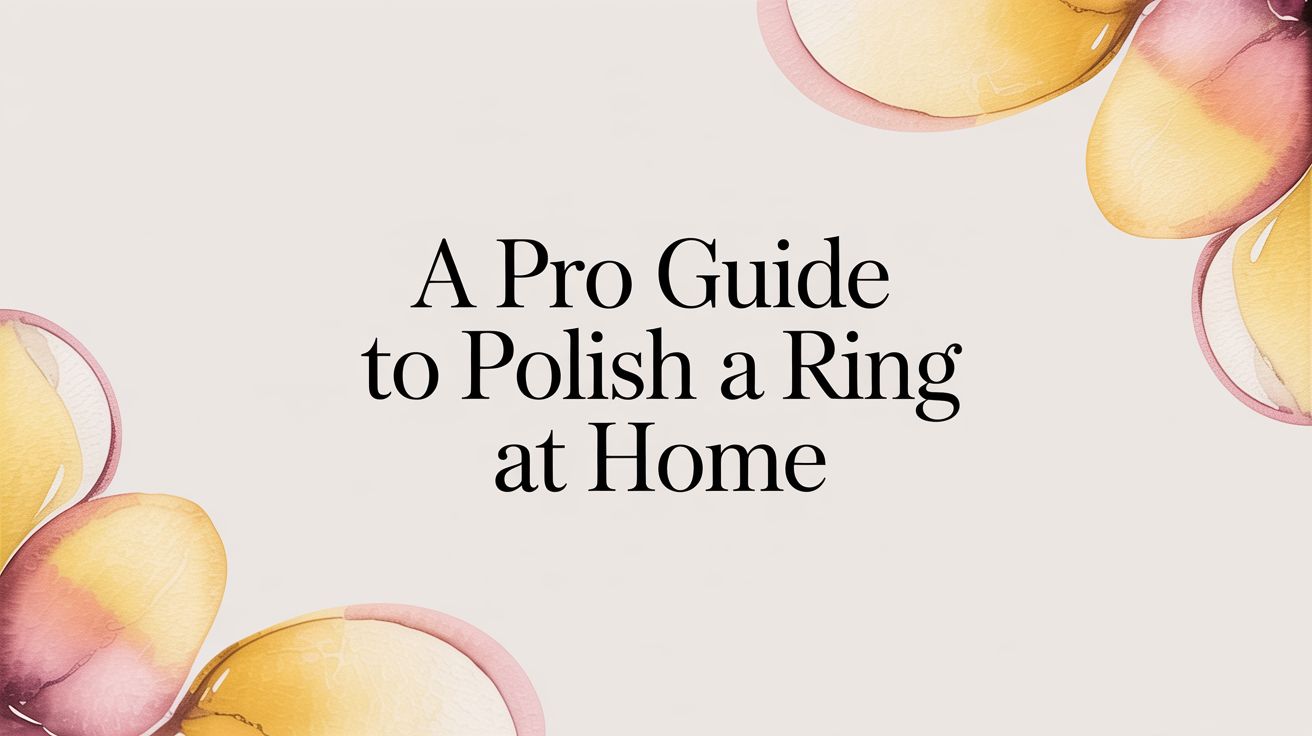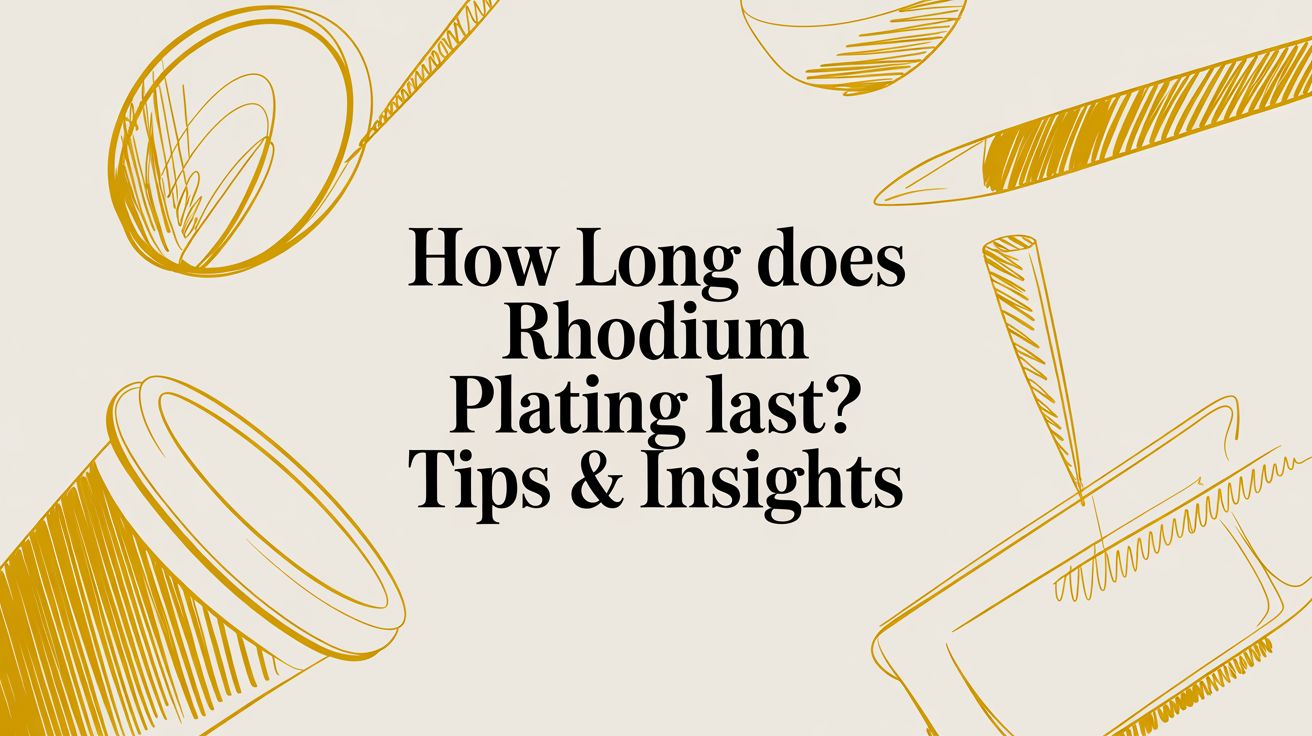Your wedding ring is with you through everything, a constant symbol of your commitment. But have you ever stopped to think what daily life leaves behind on it? Over time, hand lotions, natural skin oils, and general grime build up a dull film, hiding the true sparkle of the metal and any gemstones.
Keeping your wedding ring clean is a simple but vital act of care. It's about more than just looks; it's about preserving the beauty and integrity of a piece you'll wear for a lifetime.
Why You Need a Ring Cleaning Routine
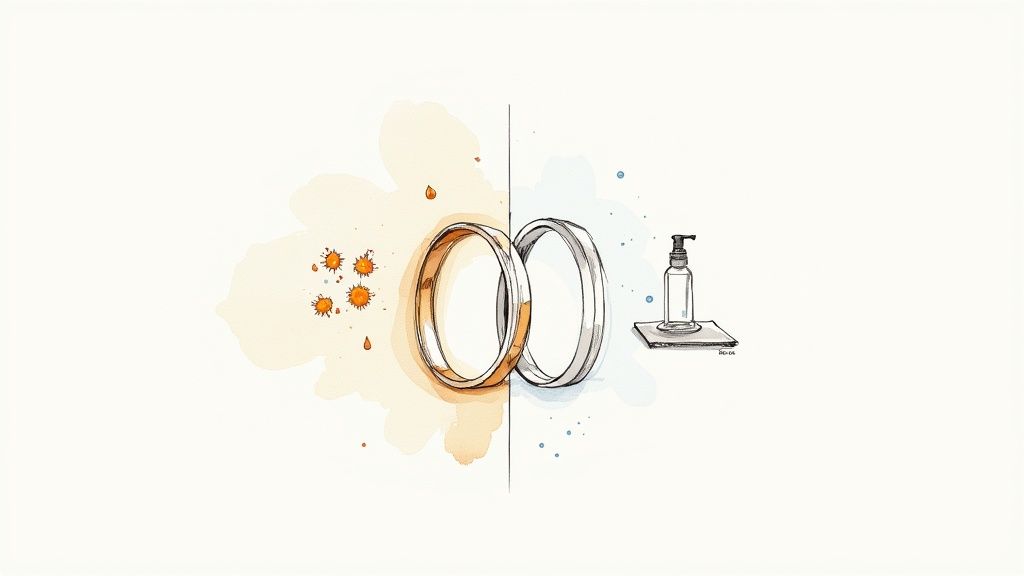
It’s easy to assume that something you wear every day stays clean enough, especially with regular handwashing. The reality is, soap scum and hand creams are often the biggest culprits behind a ring losing its brilliance. This buildup doesn’t just look dull—it can become a hygiene issue.
That film can trap moisture and bacteria against your skin, sometimes leading to irritation or a mild rash. For rings with intricate details, like pavé settings or fine engravings, those tiny crevices become perfect hiding spots for dirt and germs.
More Common Than You Think
This is an incredibly common oversight. A 2023 UK survey found that a staggering 66% of Brits never clean their jewellery. That’s a bit concerning when you consider that porous gemstones and even soft metals can harbour bacteria, sweat, and dirt, all of which dull the ring's appearance over time. You can learn more about these jewellery habits and see the full survey results.
A consistent cleaning routine is about much more than just sparkle. It’s an essential practice to ensure your ring stays beautiful, hygienic, and structurally sound for years to come.
Key Takeaway: A regular cleaning schedule does more than restore shine—it removes harmful buildup, prevents skin irritation, and gives you a chance to inspect your ring for any potential issues, like loose prongs, before they become serious problems.
This guide will walk you through practical, safe methods for keeping your wedding ring as radiant as the day you first put it on.
Gathering Your At-Home Cleaning Supplies
Before you even think about cleaning your ring, getting the right tools together is the most important step. You don't need a fancy, professional setup; in fact, the best and safest supplies are probably already in your kitchen and bathroom cupboards. The key is to think gentle and non-abrasive.
Our goal here is simple: lift away the daily grime, oils, and lotion residue without scratching the metal or, worse, damaging a delicate gemstone setting. Forget reaching for harsh household cleaners like bleach, acetone, or abrasive powders. These can cause irreversible damage to precious metals and completely ruin certain stones.
Your Essential Cleaning Kit
Get these few items ready before you start:
- A small bowl: Anything big enough to completely submerge your ring will do the trick.
- Mild dish soap: Look for a gentle, ammonia-free formula. It’s designed to cut through grease and oil without being corrosive.
- A very soft-bristled brush: A baby's toothbrush is perfect for this. The bristles are soft enough to work their way into all the tiny crevices around the setting without leaving micro-scratches.
- A soft, lint-free cloth: A microfibre cloth, like the one you'd use for your glasses, is ideal. It will dry and polish your ring to a perfect, streak-free shine.
A Jeweller's Tip: Always, always plug the sink drain before you start. It’s a simple habit that has saved countless rings from a heart-stopping trip down the pipes.
That's it. With just these basic supplies, you have everything you need to safely restore your ring's brilliance. It’s the same straightforward method we recommend to all our clients for regular at-home care.
Matching the Method to Your Ring
Applying a one-size-fits-all approach to cleaning wedding rings is a recipe for disaster. A method that makes a platinum and diamond ring sparkle could permanently damage a delicate opal or tarnish antique gold. Knowing exactly what your ring is made of is the first and most critical step in safe, effective at-home care.
The gemstone should always be your primary consideration. Some stones, like diamonds, are incredibly durable and can handle a bit more elbow grease. Others are soft, porous, or treated, making them highly vulnerable to chemicals, heat, and even vigorous scrubbing. You wouldn't clean a delicate painting with window cleaner, and the same logic applies here.
This quick decision tree helps you determine the right path based on your ring's stone.
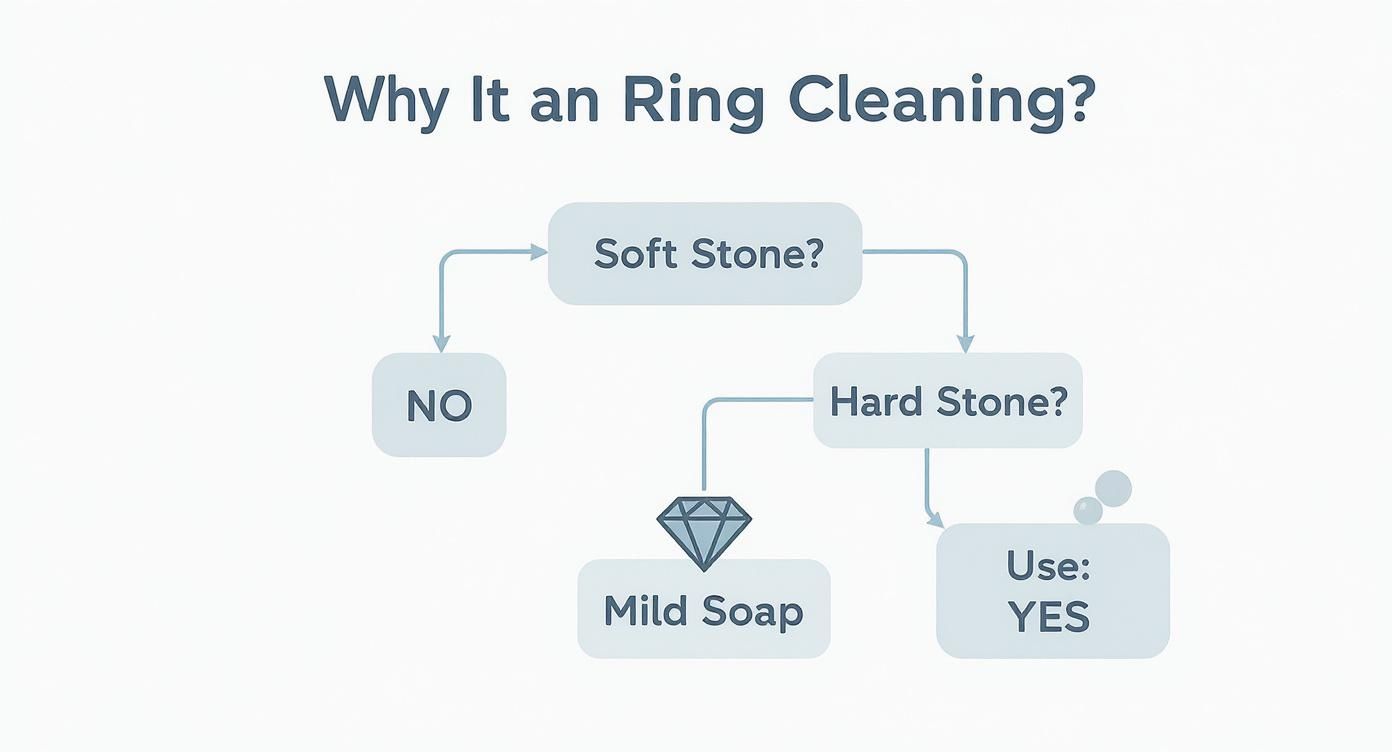
This visual guide simplifies things: if your ring features a hard, durable stone like a diamond, a mild soap solution is your safest bet. If it has a soft or porous stone, you need to avoid soaking and any harsh methods altogether.
Care for Gold, Platinum and Diamonds
Most modern wedding rings are crafted from pretty tough materials. Metals like platinum, yellow gold, and rose gold, when paired with hard gemstones like diamonds, sapphires, or rubies, are relatively straightforward to clean.
A simple soak for 15-20 minutes in a bowl of warm water with a few drops of mild, ammonia-free washing-up liquid is usually perfect. This gentle bath loosens the daily build-up of lotions, soaps, and oils. After soaking, you can use an old baby's toothbrush to softly scrub around the setting and underneath the stone, where grime loves to hide.
For a deeper dive into gold care, you can find detailed steps on how to clean gold jewellery in our dedicated article.
To help you get started, here's a quick guide to some safe, gentle cleaning solutions you can mix up at home.
Gentle Cleaning Solutions for Your Ring
| Metal or Gemstone Type | Recommended At-Home Solution | Important Note |
|---|---|---|
| Gold, Platinum & Diamonds | Warm water with a few drops of mild, ammonia-free washing-up liquid. | Safe for soaking. Use a very soft brush to gently scrub around settings. |
| Silver & Hard Gems | A paste of baking soda and water, or mild washing-up liquid. | Avoid baking soda paste on plated items as it can be abrasive. Rinse thoroughly to prevent tarnish. |
| Sapphires & Rubies | Same as gold and diamonds: warm water and mild washing-up liquid. | These stones are very durable and can handle a gentle soak and scrub. |
| Emeralds, Opals & Pearls | A soft, lint-free cloth dampened with plain water only. | Never soak these stones. Avoid all chemicals, soaps, and ultrasonic cleaners as they can cause severe damage. |
| Turquoise & Coral (Porous) | Wipe gently with a soft, dry cloth. Use a slightly damp cloth only if absolutely necessary. | These stones are extremely porous and can absorb liquids, leading to discolouration or cracking. |
This table is a starting point, but always err on the side of caution if you're unsure about your ring's materials.
Handling Soft and Porous Gemstones
This is where you need to be extra careful. Gemstones like emeralds, opals, pearls, and turquoise are far more delicate and demand a completely different approach.
- Avoid Soaking: Never submerge rings with these stones. Porous gems like opals can absorb water, which can cause them to crack as they dry.
- Gentle Wiping Only: Use a soft, damp, lint-free cloth to gently wipe the surface of the stone and metal. A soft, dry brush can be used to flick away any loose debris.
- No Chemicals: Stick to plain water. Even mild soap can damage the surface or special treatments on stones like emeralds, which are often oil-treated to enhance their clarity.
An ultrasonic cleaner, for instance, uses high-frequency sound waves to blast away dirt. While highly effective for a simple diamond solitaire, those same vibrations can shatter an emerald or cause a pearl's outer layer to peel. Always know what your ring is made of before attempting any deep clean.
If you're ever in doubt about your ring's composition or the safety of a cleaning method, it's always best to stop. A quick consultation with a professional jeweller can prevent a costly and heartbreaking mistake, ensuring your cherished ring remains pristine for years to come.
Common Cleaning Mistakes You Need to Avoid
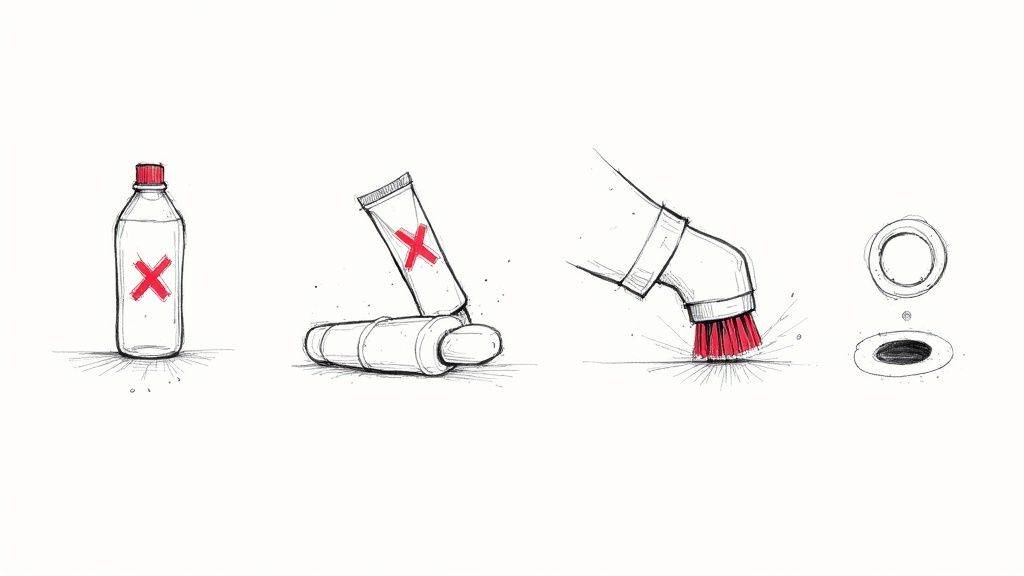
Even with the best intentions, it’s surprisingly easy to cause lasting damage when cleaning a wedding ring. Knowing what not to do is just as important as knowing the right method, and many common household products can harm your cherished jewellery.
One of the biggest culprits is harsh chemicals. Things like bleach, chlorine, and acetone (the main ingredient in nail polish remover) can react with the alloys in gold, causing discolouration and even structural weakness over time. For delicate gemstones, the damage can be permanent.
Another common mistake is reaching for anything abrasive. Toothpaste and powdered cleaners might seem like a good way to scrub off grime, but they’re designed to be gritty. These can create thousands of tiny scratches on the surface of softer metals like gold, slowly dulling its shine.
Subtle Habits That Cause Damage
It's not just about the cleaning products. Some everyday habits pose a real risk to your ring's integrity, and they're easy to overlook.
- Using Stiff Brushes: A standard toothbrush, even a "soft" one, can have bristles that are far too stiff. These can scratch both the metal band and softer gemstones. Always opt for a baby's first toothbrush—their bristles are exceptionally gentle.
- Cleaning Over an Open Drain: This is a classic, heart-stopping mistake. It only takes one slip. Always make sure the sink plug is securely in place before you start rinsing your ring.
- Ignoring Temperature Shocks: Plunging a cold ring into hot water can cause thermal shock. For certain gemstones like opals or emeralds, this can lead to internal fractures or cracks. Always use lukewarm water.
Crucial Reminder: Most white gold rings are plated with rhodium to give them that brilliant, cool-white shine. Harsh chemicals and abrasive cleaning can strip this thin layer away far more quickly, exposing the naturally warmer, yellowish gold underneath.
Understanding how long rhodium plating should last can help you spot if premature wear is happening due to your cleaning routine. By steering clear of these common pitfalls, you can ensure your at-home efforts preserve your ring’s beauty, rather than diminish it.
How Often Should You Clean Your Ring?
Figuring out the right cleaning schedule is the secret to keeping your ring’s sparkle alive without it feeling like a constant chore. The best approach is a simple, sustainable routine that mixes quick at-home cleans with essential professional check-ups.
Your lifestyle is the biggest factor here. If you’re often cooking, gardening, or using hand lotions, your ring is going to collect grime much faster than one worn only on special occasions.
For a ring you wear daily, a light at-home clean every one to two weeks is a brilliant rule of thumb. This isn't a deep scrub; just a quick soak in warm water with a drop of mild washing-up liquid, followed by a gentle once-over with a soft toothbrush. It’s enough to lift fresh oils and residue before they build up. You can read more about why this simple routine keeps wedding rings sparkling to maintain that just-bought brilliance.
The Importance of Professional Inspections
While your at-home efforts are fantastic for day-to-day shine, they can’t get into every nook and cranny. That’s where a professional jeweller comes in.
We highly recommend a professional deep clean and inspection twice a year. Think of it as your ring's MOT. A jeweller has access to specialised tools like ultrasonic tanks and high-pressure steam cleaners that safely blast away the stubborn, compacted grime your toothbrush can't touch.
A professional check-up is about more than just a superior clean. It's a critical opportunity for an expert to inspect the security of settings and prongs, preventing the tragedy of a loose or lost stone.
This two-part strategy—frequent, gentle cleaning at home combined with biannual professional servicing—is the gold standard for ring care. It ensures your treasured piece remains secure, brilliant, and ready for a lifetime of wear.
If you feel your ring is due for an expert eye, learn more about our professional jewellery cleaning service in London and how we can bring its fire back to life.
Common Questions About Ring Cleaning
Even with the best guides, specific questions always pop up. It's completely normal to want a bit of extra reassurance before you start cleaning a piece that means so much. Here are the clear, straightforward answers to the queries we hear most often in our workshop.
Can I Use an Ultrasonic Cleaner at Home?
These machines can give a fantastic, deep clean to very durable rings—think a simple diamond solitaire in a platinum band. However, they're a huge risk for any ring with softer or porous stones like opals, emeralds, or pearls. The intense vibrations can easily cause fractures.
We also see them loosen the tiny stones in delicate pavé or intricate vintage settings all the time.
Our Advice: Unless your ring is a very simple, sturdy design with a hard gemstone like a diamond, it's best to leave ultrasonic cleaning to the professionals. If you're even slightly unsure, just ask a jeweller first. It's not worth the risk.
Is Baking Soda a Safe Way to Clean My Ring?
While it’s a popular DIY hack you’ll see all over the internet, most professional jewellers strongly advise against using baking soda. It's a mild abrasive, and over time, it will create thousands of microscopic scratches on the surface of softer metals like gold. This gradually dulls that beautiful high-polish finish.
There's a much safer and equally effective way to cut through everyday grease and grime: a simple bowl of warm water with a few drops of mild washing-up liquid. It does the job perfectly without causing any damage.
My White Gold Ring Looks Yellow—Will Cleaning Fix It?
A good clean will definitely restore your ring's sparkle by removing built-up dirt and oils, but it won’t fix a yellowish tint. White gold is made by mixing pure yellow gold with white metal alloys and then plating it with rhodium to get that bright, silvery-white finish.
This rhodium plating naturally wears away with time, slowly revealing the warmer gold colour underneath. If your ring has taken on a noticeable yellow hue, it doesn't need cleaning—it needs to be re-plated by a professional jeweller to bring back its original crisp, white colour.
At Opulence Jewellery Services, our expert jewellers use professional-grade tools to safely and thoroughly clean any piece, ensuring every gemstone and setting is inspected for security. Visit our London workshop to restore your ring's original brilliance. Learn more about our jewellery cleaning and repair services.
